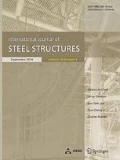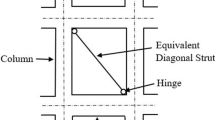Abstract
This paper aims to probabilistically evaluate the influences of drilled flange (DF) connection on seismic performance of steel moment frames (SMFs) incorporating near-field ground motions. Meanwhile, reduce beam section (RBS) connection as a prequalified connection and pre-Northridge welded unreinforced flange (WUF) connection were compared with DF connection. To model accurately the components of RBS and WUF connections and panel zone in SMFs, the proposed models of former researches were utilized. However, to simulate all DF connections the hinge properties were extracted from experimentally validated finite element models. Two sample low- and high-rise buildings were designed based on valid codes and simulated by OpenSees platform in order to study the nonlinear performance of aforementioned connections. Incremental dynamic analysis process was carried out to assess comprehensively the effect of DF connection on structural response and probability of structural instability for various intensity of seismic loads. Then, the seismic risk for Collapse Prevention and immediate occupancy limit states were calculated by fragility analysis. Also, seismic demand hazard curves for the sample buildings were extracted. The results of this study indicated that DF connections provided acceptable seismic performance as well as RBS connections in low- and high-rise buildings.













Similar content being viewed by others
References
AISC 341. (2005). Seismic provisions for structural steel buildings. Chicago, Illinois: AISC.
AISC 358. (2016). Prequalified connections for special and intermediate steel moment frames for seismic applications. Chicago, Illinois: AISC.
AISC 360. (2005). Specification for structural steel buildings. Chicago, Illinois: AISC.
ANSYS. (1998). User’s manual, version 5.4. 201. Johnson Road, Houston: ANSYS Inc.
ASCE/SEI 7. (2005). Minimum design loads for buildings and other structures. Reston, VA: American Society of Civil Engineers.
ASCE/SEI 41. (2013). Seismic rehabilitation of existing buildings. Reston, VA: American Society of Civil Engineers.
Atashzaban, A., Hajirasouliha, I., Jazany, R. A., & Izadinia, M. (2015). Optimum drilled flange moment resisting connections for seismic regions. Journal of Constructional Steel Research, 112, 325–338.
ATC 24. (1992). Guidelines for cyclic seismic testing of components of steel structures. Redwood City, California: Applied Technology Council.
Chi, B., & Uang, C. M. (2002). Cyclic response and design recommendations of reduced beam section moment connections with deep columns. Journal of Structural Engineering, 128(4), 464–473.
Deylami, A., & Tabar, A. M. (2013). Promotion of cyclic behavior of reduced beam section connections restraining beam web to local buckling. Thin-Walled Structures, 73, 112–120.
Engelhardt, M. D., Fry, G., Jones, S., Venti, M., & Holliday, S. (2000). Behavior and design of radius cut reduced beam section connections. Rep. No. SAC/BD-00, 17.
Farrokhi, H., Danesh, F., & Eshghi, S. (2009). A modified moment resisting connection for ductile steel frames (Numerical and experimental investigation). Journal of Constructional Steel Research, 65(10), 2040–2049.
FEMA 276. (1997). Guidelines for the seismic rehabilitation of buildings: Example applications. Washington, DC: Federal Emergency Management Agency.
FEMA 355D. (2000). State of the art report on connection performance. Washington, DC: Federal Emergency Management Agency.
FEMA 356. (2000). Prestandard and commentary for the seismic rehabilitation of buildings. Washington, DC: Federal Emergency Management Agency.
FEMA P695. (2009). recommended methodology for quantification of building system performance and response parameters. Washington, DC: Federal Emergency Management Agency.
Han, S. W., Kwon, G. U., & Moon, K. H. (2007). Cyclic behaviour of post-Northridge WUF-B connections. Journal of Constructional Steel Research, 63(3), 365–374.
Ibarra, L. F., & Krawinkler, H. (2005). Global collapse of frame structures under seismic excitations. Berkeley: Pacific Earthquake Engineering Research Center.
Ibarra, L. F., Medina, R. A., & Krawinkler, H. (2005). Hysteretic models that incorporate strength and stiffness deterioration. Earthquake Engineering and Structural Dynamics, 34(12), 1489–1511.
IBC. (2006). International building code. Birmingham, AL: International Code Council.
Kai, R., Su, L., & Lee, C. L. (2013). Development of seismic fragility curves for low-rise masonry infilled reinforced concrete buildings by a coefficient-based method. Earthquake Engineering and Engineering Vibration, 12(2), 319.
Krawinkler, H. (2000). State of the art report on systems performance of steel moment frames subject to earthquake ground shaking. Prepared for the SAC Joint Venture, Published by the Federal Emergency Management Agency, FEMA-355 C, Washington, DC.
Le-Trung, K., Lee, K., Lee, J., & Lee, D. H. (2010). Seismic demand evaluation of steel MRF buildings with simple and detailed connection models. International Journal of Steel Structures, 10(1), 15–34.
Liel, A. B., Haselton, C. B., Deierlein, G. G., & Baker, J. W. (2009). Incorporating modeling uncertainties in the assessment of seismic collapse risk of buildings. Structural Safety, 31(2), 197–211.
Lignos, D. G. (2008). Sidesway collapse of deteriorating structural systems under seismic excitations. ProQuest.
McKenna, F., Fenves, G. L., & Scott, M. H. (2000). Open system for earthquake engineering simulation. Berkeley: University of California.
Moon, K. H., & Han, S. W. (2008). Seismic performance evaluation of steel moment resisting frames with WUF-B connections. In AIP conference proceedings (Vol. 1020, No. 1, pp. 1871–1878). AIP.
Porter, K. A. (2003). An overview of PEER’s performance-based earthquake engineering methodology. In Proceedings of ninth international conference on applications of statistics and probability in civil engineering.
Porter, K., Hamburger, R., & Kennedy, R. (2007). Practical development and application of fragility functions. In Structural engineering research frontiers (pp. 1–16).
United States Geological Survey (USGS). US design maps. U.S. geological survey. http://earthquake.usgs.gov/hazards/designmaps. Accessed 17 June 2018.
Vamvatsikos, D., & Cornell, C. A. (2002). Incremental dynamic analysis. Earthquake Engineering and Structural Dynamics, 31(3), 491–514.
Veismoradi, S., Amiri, G. G., & Darvishan, E. (2016). Probabilistic seismic assessment of buckling restrained braces and yielding brace systems. International Journal of Steel Structures, 3(16), 831–843.
Vetr, M., & Haddad, A. (2010). Study of drilled flange connection in moment resisting frames. Report No. 3732, International Institute of Earthquake Engineering and Seismology, Tehran, Iran.
Vetr, M., Miri, M., & Haddad, A. (2012). Seismic behavior of a new reduced beam section connection by drilled holes arrangement (RBS_DHA) on the beam flanges through experimental studies. In 15th world conference of earthquake engineering (15WCEE), Lisbon, Portugal.
Vetr, M. G., Nouri, A. R., & Kalantari, A. (2016). Seismic evaluation of rocking structures through performance assessment and fragility analysis. Earthquake Engineering and Engineering Vibration, 15(1), 115.
Acknowledgements
Special thanks to Dr. S. H. Rahmati and Dr. M. S. Mehrparvar for all their sincere cooperation during this research.
Author information
Authors and Affiliations
Corresponding author
Rights and permissions
About this article
Cite this article
Maleki, M., Ahmady Jazany, R. & Ghobadi, M.S. Probabilistic Seismic Assessment of SMFs with Drilled Flange Connections Subjected to Near-Field Ground Motions. Int J Steel Struct 19, 224–240 (2019). https://doi.org/10.1007/s13296-018-0112-0
Received:
Accepted:
Published:
Issue Date:
DOI: https://doi.org/10.1007/s13296-018-0112-0




